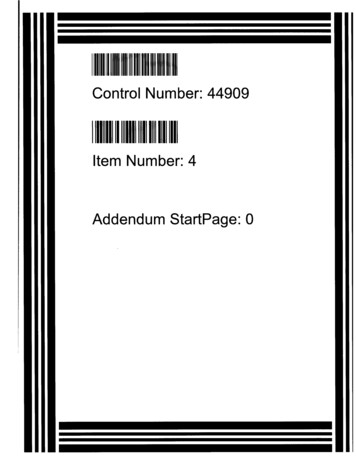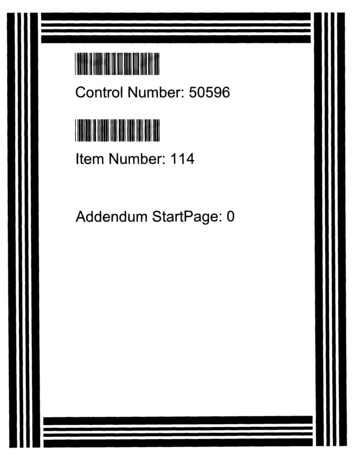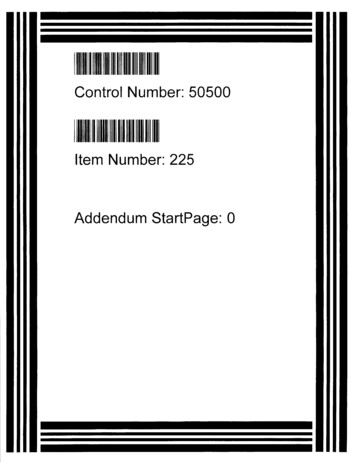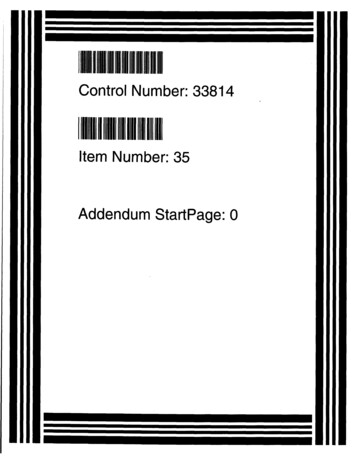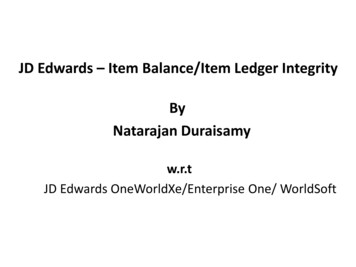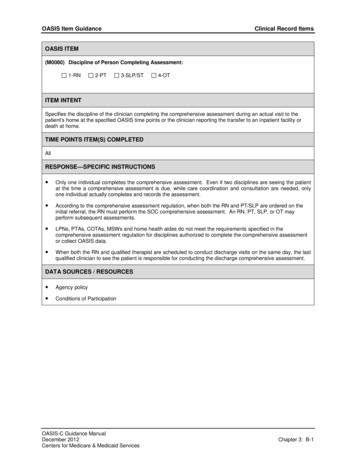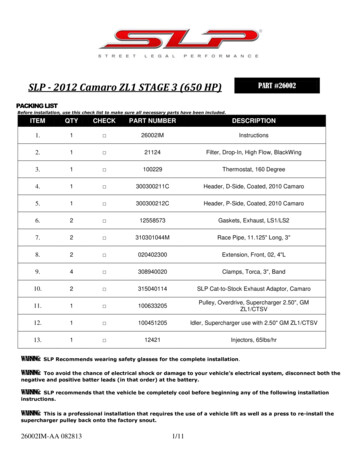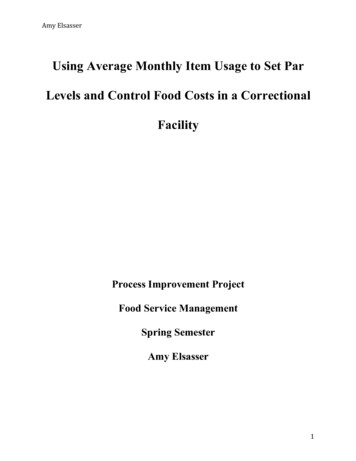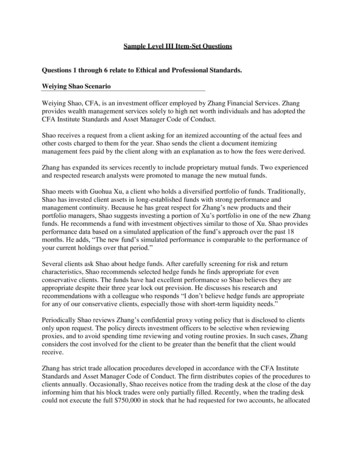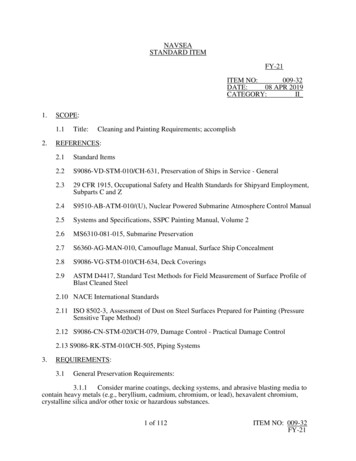
Transcription
111111111111 1111111111Controlumber: 50595111111111111111111111111Item Number: 2Addendum StartPage: 0
Public Utility Commission of Texas2028 11AR 1 8Ail 9: 33rEmployee Training ReportCLL ,Required by 16 Texas Admin. Code § 25.97(d)PROJECT NO.50595AFFECTED ENTITY:Bowie-Cass Electric Cooperative, Inc.General InformationPursuant to 16 Texas Admin. Code § 25.97(d)(2), not later than the 30th day after the date an affectedentity finalizes a material change to a document or training program, the affected entity must submit anupdated report. The first report must be submitted not later than May 1, 2020.Answer all questions, fill-in all blanks, and have the report notarized in the Affidavit.Ifidx, itA representative of the affected entity must swear to and affirm the truthfulness, correctness, andcompleteness of the information provided by attaching a signed and notarized copy of the Affidavitprovided with this form.Submit four copies (an original and three copies) of the completed form and signed and notarized Affidavitto:Central Records Filing ClerkPublic Utility Commission of Texas1701 N. Congress AvenueP.O. Box 13326Austin, Texas 78711-3326Telephone: (512) 936-7180Employee Training ReportForm Last Updated in Project No. 49827Page 1 of 4
Affected Entity: Bowie-Cass Electric Cooperative, Inc.PROJECT NO. 505951. Provide a summary description of hazard recognition training documents you provideyour employees related to overhead transmission and distribution facilities.Bowie-Cass Electric Cooperative, Inc. (BCE) has a three-tracked training program for employees,generally broken into: line employees, office employees with "field" duties and office (only)employees. Line employees generally perform maintenance and construction duties in the field.Office employees with "field" duties perform a portion of their work in the office and a portion in thefield. Office (only) employees do not have any assigned work tasks outside of the office.Office (only) employees are provided a modest amount of training regarding overhead transmissionand distribution facilities. All office employees receive hazard training on subjects such as: don't gonear or touch a downed power line; call 911 if a downed power line might cause a life threateningsituation; and basic vertical NESC electrical clearances as contained on standard BCE drawings.Office employees with field duties are provided basic electrical hazard training as listed abovetogether with more advanced hazard recognition training. These employees consist of: stakingtechnicians, field employee supervisors; and right-of-way maintenance coordinators.Staking technicians receive training on distribution line design that is aimed at eliminating electricalhazards during the initial design of facilities. The training for design of NESC compliant facilitiesincludes vertical clearance design, adjacent facilities/trees/structures management, minimumhorizontal clearances, strength of poles, materials and equipment, and electrical structureappropriateness. These initial designs, in the form of staking sheets, are reviewed by an engineeror experienced line designer prior to issuing for construction to ensure that hazards are eliminated.Field employee supervisors typically receive the same hazard training as their field employees andthe training is supplemented with annual hazard training on subjects of safety, appropriate workpractices and human resources related training to recognize instances or issues that might lead tounsafe work practices. Supervisors also receive training in NESC compliance for vertical andhorizontal clearances requirements to limit electrical hazards to employees and the general public.Right-of-way maintenance coordinators coordinate the work of contract right-of-way clearing crews,but aren't on site with any crew on an ongoing basis. BCE coordinators have extensive lineclearing experience and have been trained to recognize hazards relating to that job duty and tohazards relating to minimum NESC vertical and horizontal clearances for electric facilities to limitelectrical hazards to employees and the general public.Line employees perform maintenance and construction duties in the field and must completerequired classes and training in addition to learning from more experienced personnel -- all of thisaimed at managing hazards while performing electric line work. Line workers begin with training forbasic issues such as safe commercial vehicle operation, rubber (insulated electrical) glove careand use, minimum approach distances, whether a pole is sound and acceptable to climb, climbinga pole and what position to be in on the pole to perform basic functions. Mid-level training includesbucket truck operation, line work from a bucket under the direct supervision of an experienceemployee in the same bucket, advanced minimum approach distances, and standard transformerconnections and applications. Higher level training includes work from a bucket alone in thebucket, capacitor and regulator operation and maintenance, and standard banked transformerconnections and applications. During each of these training regimens, hazards are identified anddiscussed to minimize hazard impacts upon the line worker(s) and the general public. Lineemployees also receive training in NESC compliance for vertical and horizontal clearancesrequirements for electric facilities to limit electrical hazards to employees and the general public.Hazard awareness training is provided by cooperative staff through weekly safety meetings, andcooperative staff, TEC and TEEX trainers through monthly safety meetings.Employee Training ReportForm Last Updated in Project No. 49827Page 2 of 4
Affected Entity: Bowie-Cass Electric Cooperative, Inc.PROJECT NO. 505952. Provide a summary description of training programs you provide your employees relatedto the National Electrical Safety Code for construction of electric transmission anddistribution lines.Bowie-Cass Electric Cooperative, Inc. (BCE) has two basic NESC training programs for employees:electric design employees and all others.Electric design employees are engineers and staking technicians that receive training on distributionline design that is aimed at eliminating hazards through the initial design of facilities. BCE utilizesstandardized materials, equipment and specifications compiled and issued by the USDA Rural UtilitiesService, formerly the Rural Electrification Administration (REA). Standardization of specificationsallows a design to be mathematically and operationally proven and then used on a continuing basis.Typically, NESC compliance of materials is ensured by calculating "normal" construction designparameters and reusing that same, standardized design for future project needs. Additional training fordesign of NESC compliant facilities includes vertical clearance design, adjacentfacilities/trees/structures management, minimum horizontal clearances, and appropriate use of poleclass, materials and equipment, and electrical structure designs. These initial designs, in the form ofstaking sheets, are reviewed by an engineer or experienced line designer prior to issuing forconstruction to ensure that electrical hazards are eliminated."All others" employees are generally trained to ensure compliance to NESC vertical and horizontalelectrical clearances. Office employees are trained conceming basic vertical clearances and easementwidths as contained on all BCE "Meter Pole Specifications". Employees who work in the "field";lineworkers, supervisors and right-of-way coordinators are trained to recognize instances of electricalhazards for minimum vertical clearance, adjacent facilities/trees/structures encroachment, minimumhorizontal clearances, and conflicts with neighboring electric and tele-com utilities per NESCspecifications. Construction crews regularly measure and record the height of road and drivewaycrossings on the completed project staking sheets for office review of compliance with NESC minimumrequirements.NESC design and construction compliance training is provided by cooperative staff, TEC and TEEXtrainers as a part of monthly safety meetings. NESC design and construction compliance training isalso provided through occasional off-site classes attended by staking technicians, engineers,supervisors and line personnel.Employee Trainin,g ReportForm Last Updated in Project No. 49827Page 3 of 4
Affected Entity: Bowie-Cass Electric Cooperative, Inc.PROJECT NO. 50595AFFIDAVITI swear or affirm that I have personal knowledge of the facts stated in this report or am relying on peoplewith personal knowledge, that I am competent to testify to thern, and that I have the authority to submit thisreport on behalf of the affected entity. I further swear or affirm that all statements rnade in this report aretrue, correct, and complete.Ax06-60,0SignatureTod Corbin, P.E.Printed NaineManager of Engineering and OperationsJob TitleBowie-Cass Electric Cooperative, Inc.Name of Affected EntitySworn and subscribed before me this11.t/ /4KATHRINE FRYNotary Public, State of Texas :. Comm. Expires 09-28-2020orilZ'osNotary ID 129143363Employee Training ReportForm Last Updated in Project No. 49827day of inaranMonthNotary Public in and For the State ofMy commission expires on, 2.0ZO.YearT-ux( 6qPage 4 of 4
Bowie-Cass Electric Cooperative, Inc. (BCE) has two basic NESC training programs for employees: electric design employees and all others. Electric design employees are engineers and staking technicians that receive training on distribution line design that is aimed at eliminating hazards through the initial design of facilities. BCE utilizes standardized materials, equipment and specifications .
